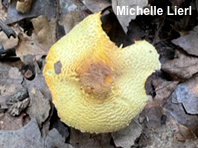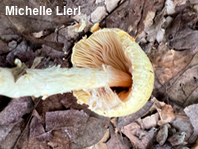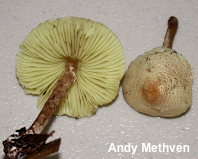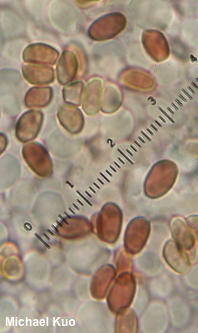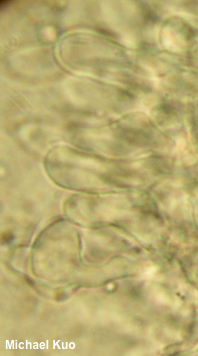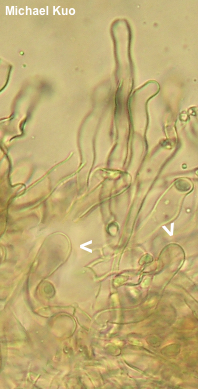| Major Groups > Gilled Mushrooms > Pale-Spored > Lepiotoid Mushrooms > Lepiota xanthophylla |

|
[ Basidiomycota > Agaricales > Agaricaceae > Lepiota . . . ] Lepiota xanthophylla by Michael Kuo, 4 October 2023 This is a distinctive lepiotoid mushroom with yellow gills and small brown scales on its yellowish cap. It is a woodland European species, and its distribution in North America is uncertain, although it may be limited to urban settings in the southeastern and lower Midwestern United States, where it appears to have been introduced with woodchips. Lepiota xanthophylla is very similar to Lepiota elaiophylla, but the latter species has olive shades in its fresh cap and gills, brownish gills when dried for the herbarium, and is known only from greenhouses in Europe. The two species also differ microscopically, in the structure of the pileipellis; Lepiota xanthophylla has a layer of club-shaped, shorter cells along with longer, skinnier cells; Lepiota elaiophylla has only the long, skinny cells. Thanks to Michelle Lierl for documenting, collecting, and preserving Lepiota xanthophylla for study; her collection is deposited in The Herbarium of Michael Kuo. Thanks to Andy Methven for facilitating study of Lepiota xanthophylla. Description: Ecology: Saprobic; growing alone or gregariously outdoors, in hardwoods forests or in woodchips; fall; originally described from England, and well documented in continental Europe and Japan; in North America apparently restricted to the southeastern United States. The illustrated and described collections are from Georgia and Indiana. Cap: 2–4 cm across; convex to broadly conic-convex; dry; fibrillose centrally, with tiny fibrillose scales elsewhere; ground color dull yellowish to yellow; scales and fibrils brown; margin with a few hanging partial veil remnants. Gills: Free from the stem; close or nearly distant; light yellow, sometimes becoming darker with maturity; short-gills frequent. Stem: 3–6 cm long; 3–5 mm thick; equal; dry; bald near the apex, but fibrillose-scaly overall; with a quickly collapsing, flimsy whitish ring; whitish to brownish; solid. Flesh: Yellowish; not changing when sliced. Odor: Not distinctive. Dried Specimens: Gills of dried specimens are pale yellow. Microscopic Features: Spores 6–10 x 3–4.5 µ; ellipsoid, often with a somewhat flattened adaxial side; smooth; hyaline in KOH; dextrinoid. Basidia 20–25 x 5–5 µm; subclavate; 4-sterigmate. Cheilocystidia in a sterile band; 30–40 x 6–15; µ; widely cylindric to subutriform, sublageniform, or subclavate; smooth; thin-walled; hyaline in KOH. Pleurocystidia not found. Pileipellis a collapsing trichoderm; terminal elements of two types: 1) 50–100+ x 5–7.5 µm, cylindric with rounded or subacute apices, smooth, hyaline to brown or reddish orange in KOH; 2) 30–50 x 5–10 µm, subclavate to clavate or sphaeropedunculate, smooth, hyaline in KOH. Clamp connections present. REFERENCES: P. D. Orton, 1960. (Breitenbach & Kränzlin, 1995; Vellinga & Huijser, 1997; Akers & Sundberg, 1998; Vellinga, 2001h; Vellinga, 2003b; Lange, 2018; Kibby, 2020.) Herb. Kuo 09292001 (portion of ASM 12479), 08172301. This site contains no information about the edibility or toxicity of mushrooms. |
© MushroomExpert.Com |
|
Cite this page as: Kuo, M. (2023, October). Lepiota xanthophylla. Retrieved from the MushroomExpert.Com Web site: http://www.mushroomexpert.com/lepiota_xanthophylla.html |
